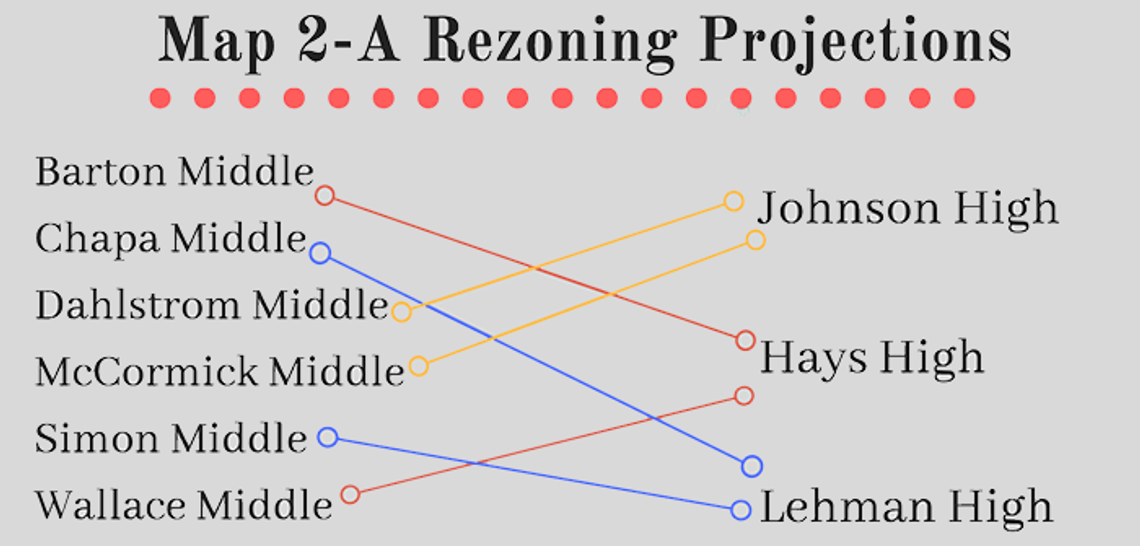What does Map 2-A mean for the future of Hays CISD?
With a new high school attendance boundary map now in place, Hays CISD parents and students know where they’ll go once the 2019 school year starts.
But Map 2-A, passed by slim 4-3 Hays CISD Board of Trustees vote, still leads some to question the future of socioeconomically disadvantaged (ED) students, which the district will work to address in the coming years.
“Barton is our largest and can hold around 1,100 students while our others can hold 900. But even if we add capacity at the middle schools, we still have smaller lunchrooms and overcrowded classrooms. It will be another talking point in the near future.”
–Sandra Bryant,
Hays CISD board member
Under Map 2-A, Lehman High will have the highest ED population in the district at 64.8 percent. Additionally, Simon Middle School, which feeds into Lehman, also has some of the highest ED numbers in the district.
Addressing high ED campuses may be a challenge, but the district is looking at a multitude of solutions to help these students excel, despite circumstances outside of the classroom.
Superintendent Eric Wright, who proposed Map 2-A, intentionally left Lehman and Simon with some breathing room in regards to overpopulation, a problem that will plague middle schools across the district within the next two years.
“We’ve had people speak to the board and infer that students from poverty aren’t as capable as those who are not and I want to dispel that rumor,” Wright said. “If I were an impoverished kid listening to those comments, it would burst my bubble.”
Wright said, historically, some of the district’s highest performing campuses had high ED populations.
Additionally, the district is currently working to implement all-day Pre-K at HCISD by as early as next year. This initiative would help students of lower socioeconomic status stay competitive in a learning environment, giving them the tools necessary to stay at pace with other students, Wright said.
“We want to equalize the difference,” Wright said. “Research shows that students from poverty are a year and a half behind in reading and learning. We are going to try to fix that with all day Pre-K, hopefully by the next school year.”
However, ED percentages was not a priority for the district’s 35-person committee tasked with crafting rezoning maps.
Top priorities were proximity, capacity balance and socioeconomic diversity. Only four people listed socioeconomic diversity as a top priority.
“When we first initially met, there were a lot of questions about ED percentages, and it was still an important part of our conversations throughout the process,” said Sandra Bryant, secretary for the rezoning committee. “Being that HCISD is a fast-growing district, ED is very important and you have to try and balance those numbers as best as you can.”
Despite efforts from Map 2-A to limit overpopulation at campuses throughout the district, the tradeoff was high ED campuses like Lehman. However, Bryant said she was “surprised” Wright created his own map after months of work put in by the committee.
“Prior to that board meeting in November, we had never heard or seen any other maps than the two the committee recommended to the board.”
Despite the new map surfacing out of the blue, Bryant said there were aspects she did like about it. However, Bryant also said high ED numbers should be addressed, considering the district’s growth.
Some district officials are also hoping HCISD will be considered a District of Innovation (DOI), per board of trustees approval, allowing for a more flexible school calendar.
Tim Savoy, HCISD chief communications officer, said becoming a DOI would allow the district to begin the school year a few days earlier.
In one example, Savoy said the district could give students an additional day off during the Martin Luther King holiday. That extra day would give teachers the opportunity to discuss topics centered around the classroom.
All of these proposals are aims that the district is taking to alleviate some of the pressures when Johnson High opens in August 2019.
“We are a large district, but we need to continue our efforts with honoring the communities we have built,” Wright said. “The neighborhood concept in our district has shown to be a priority by our community. The smaller a community feels the more connected people are.”
More middle schools on the horizon
For district officials, planning for more middle schools is the next item on their list.
Wright could not confirm that an additional middle school will be added in the near future, but did state that the middle school overpopulation needed to be addressed.
This includes potential action to expand some of the campuses to hold additional students or, if funding is available, to build a new campus.
Under Map 2-A, every middle school aside from Barton and Simon will be operating past building capacity by the 2019-20 school year.
All middle schools could experience overpopulation issues within the next decade. Bryant said adding capacity at certain schools could be a solution as well.
“Barton is our largest and can hold around 1,100 students while our others can hold 900. But even if we add capacity at the middle schools, we still have smaller lunchrooms and overcrowded classrooms,” Bryant said. “It will be another talking point in the near future.”










